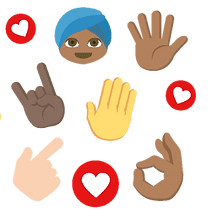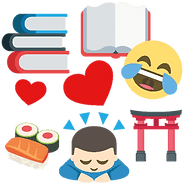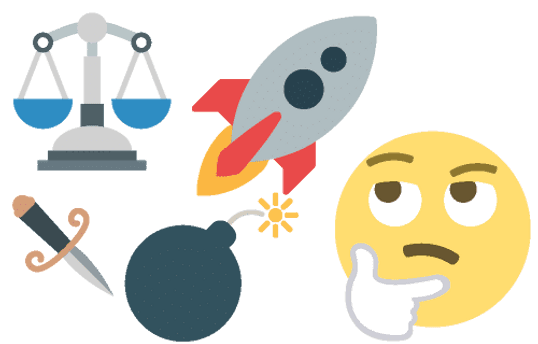Apr 06, 2023•4 min read•
The new language of Emoji
Discover the fascinating history of emojis, from their origins as simple emoticons in the 19th century to their evolution into a universal digital language. This post explores how Japanese artist Shigetaka Kurita's creations led to a global phenomenon standardized by Unicode, and how these pictograms are shaping modern communication.

Did you know that over 5 billion emoji are sent daily on Facebook messenger and that half of all comments on Instagram include an emoji? There are now over 3,600 emoji to choose from and new emoji are created every year 😯.
For many of us, the language of emoji is now an extension of our everyday language. Emoji are irreplaceable aspects of our online lexicon and have become so in just a few years following their standardisation 😊.
Where did emoji come from and why were they created?
The origins of emoji
While emoji as we know them today have only been with us since the late 1990s, the use of
simple images to communicate meaning is nothing new. The ancient Egyptians used hieroglyphics to record stories and a smiley was found on a pot unearthed in Turkey that dated back to around 1700 BC.
Emoji can trace their roots back to emoticons, representations of facial expressions formed from combinations of keyboard characters such as :). Emoticons first appeared in the 19th century and examples were published in the satirical magazine Puck in 1881. But simple emoticons were limited in their scope.
Complex emoticons
When the digital revolution arrived and mobile phones were becoming increasingly indispensable, a new lexicon of keyboard and digital characters inspired emoticon artists to get truly creative. Their impressive and funky emoticons were something to behold. But they were far too complex for common use. Simple emoticons had found favour because they enabled texters to abbreviate their messages. The more extravagant examples of emoticons would have taken days to put together 😲.
Keyboards around the world varied according to the languages spoken and so emoticons varied too. It wasn’t possible for emoticons to become a universal language. But a gap in digital communication had been exposed. The world was becoming more and more connected but languages and writing systems varied. The right symbols had the potential to facilitate brevity and to be universally understood.
Emoji revolution

Japanese artist Shigetaka Kurita is considered the founding father of emojis. In the late 1990s he created a set of 176 12-pixel images for i-mode, an early mobile internet platform from Japan’s main mobile carrier, DOCOMO. He had delivered the means for users to express emotion and to convey information in a brief and appealing way. His symbols were readily adopted and other Japanese mobile platforms began offing similar choices. Mobile platforms across the world picked up on the idea. However, there were compatibility issues between networks.
The word emoji is derived from the Japanese words 絵 (“e”, picture), 文(“mo”, write) and 字 (“ji”, character). The similarity with the English word emotion is coincidental but convenient 😃.
Universal language

Emoji characters became so popular in Japan and elsewhere that tech giants in the West couldn’t ignore what was happening. Google petitioned Unicode to recognise emoji and in 2009, Apple engineers Yasuo Kida and Peter Edberg joined the campaign.
Unicode Consortium is a not for profit organisation that unifies coding standards across computers around the world. Unicode agreed to index emoji in 2010 and so the pictograms were on their way to becoming accessible to all and to being a legitimate means of communication globally.
As tech giants Adobe, Apple, Google, Facebook, Huawei, IBM, Microsoft, Oracle, and Yahoo were all paid up members of the Unicode consortium, the Unicode emoji set was always destined to become the gold standard for emojis ✌.
Emoji for everyone
Unicode originally indexed the 625 emoji recommended by the Apple engineers, but new

examples have been added every year. Initially, the pictograms were less than representative. They featured only white people, men and foods from certain regions. This issue has been corrected over time with unicode emojis being designed to reflect different skin colours, women and foods from all regions of the world. 👳♂️
Face with tears of joy

In 2015, The Oxford Dictionary named the 😂 (face with joy and tears) emoji as its word of the year. The use of emoji had accelerated enormously that year and the choice of the emoji reflected this. The emotion expressed by the emoji also seemed appropriate for the times. Research has shown that the 😂 (face with joy and tears) emoji is the most used around the world. The ❤ (heart) emoji is the second most frequently used.
Certain emoji such as 🙇 (bowing businessman) remain specific to Japanese culture while others are used almost everywhere. Unicode Consortium founder Mark Davis has compared the use of emoji to a developing language.
More about emoji
As the use of emoji increases and yet more emoji are created, the new form of language will continue to evolve. The implications of this are yet to be fully understood. Questions are already being asked about whether emoji could be admissible as evidence in court proceedings or whether emoji dialects will form.
Many emoji are now imbued with complex meanings and emoji can be combined to convey incredibly complex emotions. Emoji can be utilised ironically or sarcastically, and their meanings can be subverted.
Some emoji have caused controversy. Multiple arrests have followed the usage of 🔫 (pistol), 🗡 (knife), and 💣 (bomb) when such usage has been deemed to be a credible threat.
It will be interesting to see how the language of emojis develops and the issues that arise with the use of the various digital images. Could an emoji prove to be the critical evidence that convicts a murderer and will most of us become fluent in emoji 🤣?

Categories
- Blog
- Digital Content
